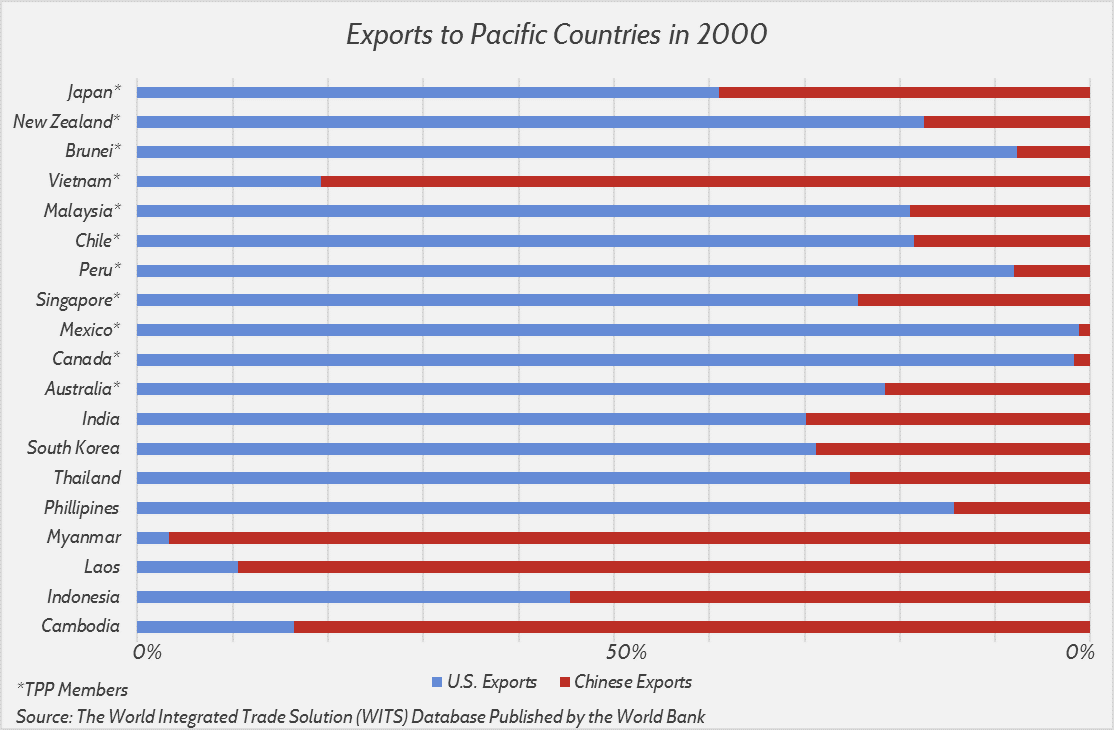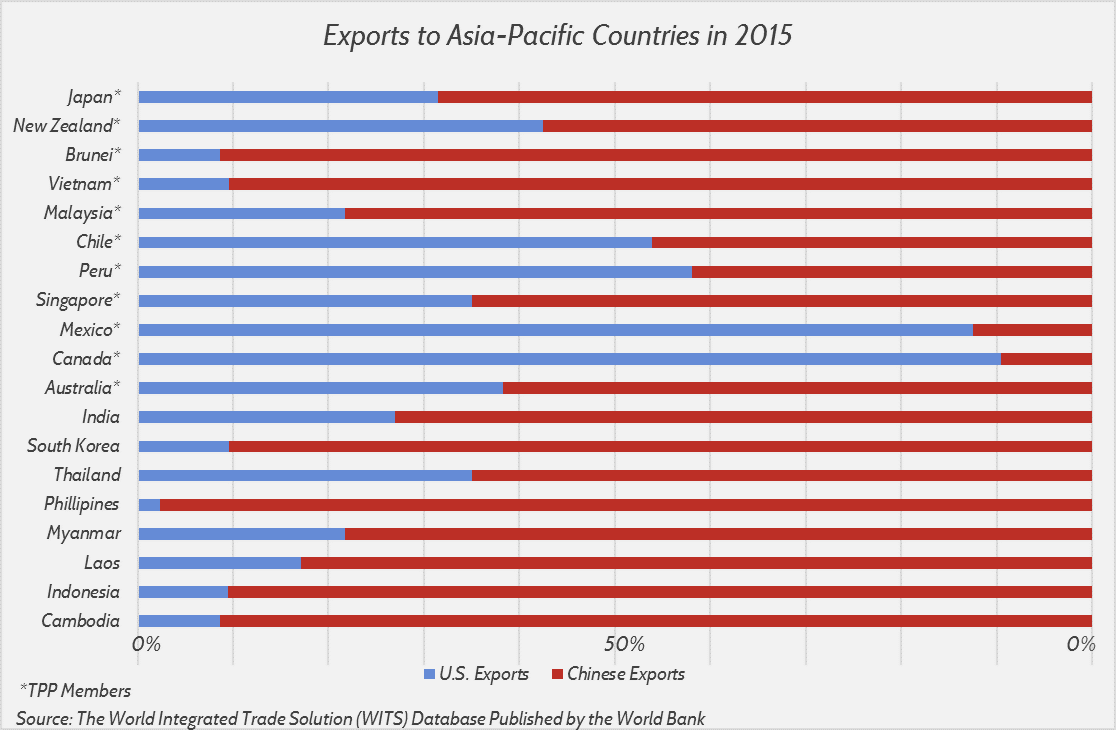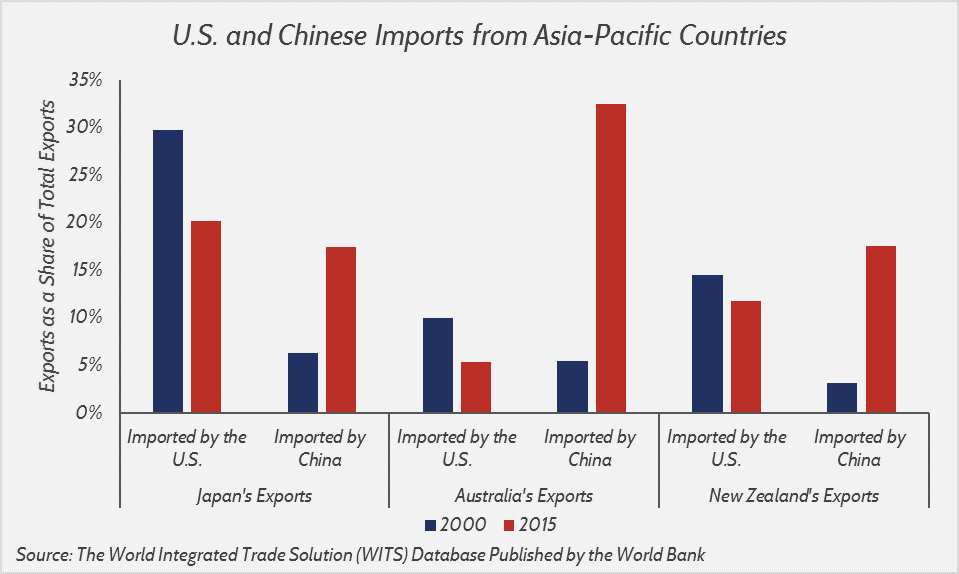Research
October 27, 2016
A Strategic Case for the Trans-Pacific Partnership
The Honorable Heather Wilson served as a Member of Congress from 1998-2008, representing New Mexico’s 1st congressional district. She served on the Armed Services, Intelligence, and Energy and Commerce Committees. Wilson is a veteran of the U.S. Air Force. She currently is the president of the South Dakota School of Mines and Technology.
Summary
- Over the past 15 years, China’s trade presence in the Asia-Pacific has grown dramatically, while U.S. economic influence has declined.
- China’s leadership on trade agreements, investment in global infrastructure, and commitment to military buildup ensure its influence in the Asia-Pacific will continue to grow regardless of whether the Trans-Pacific Partnership (TPP) is passed.
- TPP would secure continued U.S. economic influence in the Asia-Pacific, preventing China from replacing the United States as the predominant regional power in the Asia-Pacific and strengthening America’s global leadership.
Introduction
The TPP has been a source of considerable public attention and debate. This trade agreement, currently awaiting ratification by Congress, aims to lower barriers to trade between the United States, Japan, and 10 other Pacific nations. The TPP nations together represent nearly 40 percent of the global economy, making the trade agreement, if enacted, the largest in U.S. history. Equally noteworthy is the agreement’s strategic importance: TPP gives the United States an opportunity to strengthen U.S. global leadership, promote American interests in the Asia-Pacific, and counterbalance China’s influence in the region.
Benefits of TPP
In the debate over TPP thus far, trade scholars have placed significant emphasis on the agreement’s economic benefits. A study from the Peterson Institute for International Economics (PIIE) found that, by 2030, TPP would produce annual income gains of $131 billion and boost annual exports by $357 billion. The report further concluded that the United States would lose $94 billion in potential revenue each year TPP is not ratified. A similar report from the International Trade Commission (ITC), although less comprehensive, also found that TPP would generate positive economic gains for the United States.
The strategic benefits of TPP are more difficult to quantify. Numerous U.S. leaders have stressed TPP’s importance to national security, including current and former Secretaries of State and Defense, members of Congress, and other political and business leaders. Foreign leaders, such as the Prime Ministers of both Japan and New Zealand, have also spoken about the geopolitical importance of TPP. They specifically emphasized the value of strengthening relations between the United States and its regional allies—as well as the likelihood that China will fill the leadership vacuum if TPP is not enacted.
Growing Chinese Influence, Fading U.S. Presence
U.S. and Chinese Exports
Recent trade patterns clearly reveal China’s growing economic connection to the Asia-Pacific combined with a relative decline in U.S. trade activity. The following charts contrast the absolute dollar value of U.S. and Chinese exports to Asia-Pacific nations in 2000 and 2015. The nations examined below consist of the 12 current members of TPP, along with eight additional nations that could join TPP in the future. Thus far, South Korea, Indonesia, Thailand, and the Philippines have all expressed interest in becoming members.
Each full bar represents 100 percent of the total value of U.S. exports and Chinese exports combined, with U.S. exports stemming from the left in blue and Chinese exports stemming from the right in red. If the value of U.S. exports was equal to the value of Chinese exports, the bars would meet in the middle at exactly 50 percent.
In 2000, the value of U.S. exports to Asia-Pacific nations was notably greater than Chinese exports. However, by 2015, this relationship reversed. The second chart shows that China now has a much greater export presence in Asia-Pacific markets than the United States. This should not be a surprise: China overtook the United States as the world’s largest trader in 2012. Over the past 15 years, while China has built a meaningful trade relationship with many of our allies in the Asia-Pacific, the market share available to U.S. exporters has significantly decreased.
Imports to the U.S. and China
It is also valuable to evaluate how important the U.S. import market is to our TPP allies. This can be gauged by examining export trends of TPP nations. The chart below details exporting patterns of three key TPP members (Japan, Australia, and New Zealand) to both the United States and China.
Each of the three nations shown above is now sending proportionally less of its exports to the United States and more to China. For example, 30 percent of Japan’s exports were imported by the United States in 2000, while that declined to 20 percent by 2015. Similarly, the share of Australian exports imported by China jumped from 5 percent in 2000 to over 30 percent in 2015. These shifts demonstrate that our trading partners have become more reliant on China and less dependent on the U.S. import market.
China’s Trade Regime
All of the charts above depict the same story: the relative increase of Chinese economic influence in the Asia-Pacific. While it is true that China’s overall growth is part of the story, the country has also taken specific steps to strengthen its trade presence in the region and throughout the world.
Each of the potential TPP members in the charts above are in the process of negotiating the Regional Comprehensive Economic Partnership (RCEP). This is a multilateral trade agreement between China and 15 countries in Southeast Asia and the Pacific Islands, including seven TPP members. As the charts show, China’s links to the Asia-Pacific are growing and will continue to grow regardless of whether TPP is passed. Ratifying TPP would give the United States an opportunity to preempt China’s influence before RCEP enters into force.
China has also launched the One Belt, One Road strategy that provides a framework for global trade and development. While the initiative does not have official membership, it includes some 60 countries around the world, from Asia and Europe to the Middle East and Africa. By investing $4 trillion dollars in infrastructure and development, One Belt, One Road will mean a massive extension of Chinese commercial influence. The development strategy also challenges traditional conceptions of trade by presenting a global rather than regional or bilateral approach.
China has additionally established a financial structure to support One Belt, One Road: The Asian Infrastructure Investment Bank (AIIB). Specifically set up to lend money for infrastructure projects in Asian countries, the multilateral bank has already authorized $100 billion. China, of course, will be the AIIB’s largest stakeholder.
Geostrategic Realities
Trade agreements, development initiatives, and infrastructure banks are not the only things China has been working on in recent years; the Chinese government has also undertaken a significant military buildup. Between 2000 and 2015, Chinese military spending increased five-fold. China has also exerted an aggressive foreign policy, from cyber-attacks on the U.S. government to militarizing artificial islands in the South China Sea. Together, these behaviors represent a threat to the United States, the Asia-Pacific, and regional U.S. allies.
While the links between trade integration and geopolitical strategy may not always be causal, it is reasonable to assume that countries with greater economic ties will feel some pressure to align with each other strategically. This is especially true with a country like China, which has proven itself to be a geopolitical bully willing to intimidate its neighbors into partnerships.
Conclusion
In the past 15 years, the Asia-Pacific has seen troubling trends of a growing Chinese trade presence and a relative decline in U.S. economic influence. TPP could reverse these trends by lowering trade barriers and solidifying trade relationships between the United States and regional partners.
In the face of rising Chinese trade activity as well as China’s initiatives to further extend its economic engagement, the United States has two paths forward: reinvigorate U.S. regional influence through trade agreements or cede even more influence to China.
The rules for the future of commerce in the Asia-Pacific are being written. The only question is, who will write them? Will the United States choose to play an active role and ensure the trade regime favors U.S. interests and allies? Or will the United States sit back and allow China to fill the vacuum? Opposing TPP opens the door for China to replace the United States as the predominant regional power in the Asia-Pacific. Ultimately, that will hurt the domestic economy and foreign policy interests alike.













